Gas Processing News
A. Blume, Editor
Ichthys LNG project begins gas exports
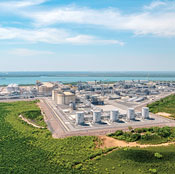 |
The first cargo of LNG from Ichthys LNG left Darwin, in the Northern Territory of Australia, in late October, following the production startup earlier in the year.
Ichthys LNG will develop reserves of more than 3 B boe located offshore Western Australia, including 500 MMbbl
of condensate. Gas production from the Ichthys field in the Browse basin began in July 2018.
At full capacity, the offshore facilities and the two-train onshore liquefaction plant will supply 8.9 MMtpy of LNG and 1.65 MMtpy of LPG, along with 100,000 bpd of condensate.
Ichthys LNG is led by INPEX (operator, 62.245%) alongside major partner Total (30%) and the Australian subsidiaries of CPC Corp. Taiwan (2.625%), Tokyo Gas (1.575%), Osaka Gas (1.2%), Kansai Electric Power (1.2%), JERA (0.735%) and Toho Gas (0.42%).
The Ichthys field and its offshore production facilities are located approximately 220 km off the coast of Western Australia.
Two offshore facilities are anchored in 250 m of water and are supplied by a subsea production network operating in tandem—a semi-submersible platform (central processing facility) for gas treatment linked to an FPSO vessel for condensate production and export.
An 890-km-long subsea gas pipeline connects the central processing facility to the liquefaction plant near Darwin.
The onshore gas liquefaction terminal is located at Bladin Point, near Darwin. It consists of two LNG trains with a combined capacity of 8.9 MMtpy and facilities for the extraction and export of LPG and condensate.
Cameron LNG commissions first export train
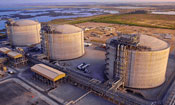 |
Sempra Energy announced in November that Cameron LNG has initiated the commissioning process for the support facilities and the first liquefaction train of Phase 1 of its liquefaction export project in Hackberry, Louisiana.
Phase 1 of the Cameron LNG liquefaction export project, which includes the first three liquefaction trains, is a $10-B facility with a projected export capability of 12 metric MMtpy of LNG, or approximately 1.7 Bft3d. All three trains are expected to be producing LNG in 2019.
The commissioning process includes testing of all support systems, combustion turbines and compressors, as well as the delivery of feed gas from the transmission pipeline and production of first LNG. Once all the steps of the commissioning process are approved by the US Federal Energy Regulatory Commission (FERC) and successfully completed for the first liquefaction train, LNG production will start and then ramp up to full production for delivery to global markets.
Cameron LNG is jointly owned by affiliates of Sempra LNG & Midstream, Total, Mitsui & Co. Ltd. and Japan LNG Investment LLC, a company jointly owned by Mitsubishi Corp. and Nippon Yusen Kabushiki Kaisha (NYK). Sempra Energy indirectly owns 50.2% of Cameron LNG.
Sempra Energy’s share of full run-rate earnings from the first three trains at Cameron LNG are projected to be between $365 MM/yr and $425 MM/yr.
Cameron LNG Phase 1 is one of five LNG export projects Sempra Energy is developing in North America. Cameron LNG Phase 2, previously authorized by FERC, encompasses up to two additional liquefaction trains and up to two additional LNG storage tanks. Sempra Energy’s other LNG development projects include Port Arthur LNG, Energía Costa Azul (ECA) LNG Phase 1 and ECA LNG Phase 2.
Italy PM gives green light to TAP gas pipeline
Prime Minister Giuseppe Conte has given Italy’s final approval to the Trans Adriatic Pipeline (TAP), a gas transport project that had been strongly contested by the 5-Star Movement, one of the two parties in the ruling coalition. “It’s no longer possible to intervene in this project, which was planned by previous governments and carries contractual constraints,” Conte said in a statement.
TAP, the last leg of the $40-B Southern Gas Corridor that will bring gas from Azerbaijan to Italy, is due to start pumping gas in 2020, but local opposition to the project has raised concern that work at the Italian end may not be completed in time. The €4.5-B ($5.13-B) TAP is viewed as strategic by the EU as it moves to wean itself off its dependency on Russian gas.
Shell Canada sees cost advantage in LNG Canada expansion
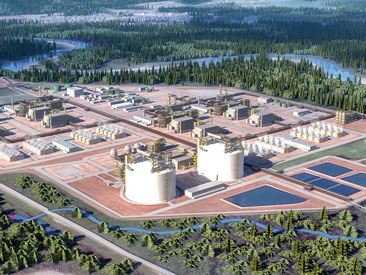 |
An expansion of LNG Canada has a cost advantage over its rivals in the race to build more LNG export capacity, but a go-ahead decision on Phase 2 is likely still a few years away, according to statements by Shell Canada in early November.
Phase 1 of the C$41-B ($31.3-B) Royal Dutch Shell-led project was given the go-ahead in October, firing up a race among companies eager to be the next to tap into booming Asian demand for LNG. The project is a JV between Shell, Malaysia’s Petronas, PetroChina Co. Ltd., Mitsubishi Corp. and Korea Gas Corp. Expansions are typically lower capital cost, which could work in Shell Canada’s favor. The expansion cost saving adds to the project’s other advantages, including a relatively short shipping distance to key Asian markets and cheap feed gas.
The question of when Phase 2, which would double output at the 14-metric-MMtpy plant to 28 metric MMtpy, will be approved remains unclear. An LNG Canada expansion would need to compete with global rivals, including options in the US, Africa and Middle East, and would depend on the market for the fuel.
LNG demand has risen sharply in recent years, led by China, gobbling up an anticipated surplus and fanning fears of a shortage by mid-next decade. Projects around the world are scrambling to secure the long-term deals needed to finance multibillion-dollar builds.
One of the key benefits for Canada-based LNG projects is access to cheap gas. Western Canadian gas prices are roughly $1 less than the US Henry Hub benchmark and are not expected to rise anytime soon.
Gas prices are so low that Shell has stopped drilling new wells at its massive Groundbirch field in northern British Columbia and will only resume in 2020 to prepare for LNG Canada shipments.
Woodfibre LNG to begin construction in early 2019
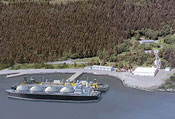 |
The small-scale Woodfibre LNG project north of Vancouver is poised to move to construction in February or March of 2019, adding momentum to Canada’s efforts to become a significant exporter of LNG.
The C$1.6-B ($1.2-B) project, backed by Indonesian billionaire Sukanto Tanoto’s RGE Group, would be Canada’s second LNG project to go ahead, following the approval of the massive LNG Canada project.
Woodfibre LNG is a relatively small project at 2.1 metric MMtpy, but it has long been touted as the frontrunner to get Canadian natural gas to Asian markets. It was given the go-ahead in 2016, but then delayed as the company worked through several issues. The company is working with engineering contractor KBR Inc. to reduce costs and awaiting a decision on import tariffs on fabricated steel components.
Woodfibre must also finalize its benefit agreement with the local Squamish Nation, which will be formally signed by council. Once a construction decision is made, the project will be completed in roughly 4 yr, ensuring first shipments by 2023.
Woodfibre has sold 100% of its first-phase output, and financing for the build is in place. The project has also secured its gas supply and is working with utility FortisBC on a 47-km (29-mi) pipeline connection.
Germany examines financing options for LNG terminal
The German government is studying options for funding to help finance an LNG terminal in Germany, according to statements by a government spokesperson in late October. Details on the location and cost have not been confirmed.
DNV GL sees faster adaptation to energy transition
DNV GL predicts faster, more agile and cleaner oil and gas production techniques to emerge over the coming decades as the industry adapts to the unfolding energy transition. The technical advisor to the sector believes that fossil fuel production must become more socially conscious and cost-competitive against an increasing share of renewables in the global energy mix in the coming decades.
According to DNV GL’s “2018 energy transition outlook” report, an independent forecast of the world energy mix in the lead-up to 2050, oil and gas demand will peak in 2023 and 2034, respectively. However, new oilfields will be needed until at least the 2040s, while new gas developments will be required beyond 2050. DNV GL’s report predicts that operators will favor production from a greater number of smaller reservoirs with shorter lifespans, lower breakeven costs and reduced social impact compared to those now in operation.
DNV GL recommends that existing technologies for decarbonization, such as carbon capture and storage (CCS), will also need to be implemented at scale for the oil and gas sector to stay relevant in a rapidly decarbonizing energy mix. The report forecasts that CCS will capture only 1.5% of emissions related to energy and industrial processes in 2050.
Global warming will likely reach 2.6°C above pre-industrial levels in 2050, according to the report. This is well above the 2°C target set by the COP 21 Paris Agreement on climate change. By 2050, the Outlook predicts 972 metric gigatons of carbon will be emitted, overshooting the 810-metric-gigaton budget associated with the target.
Argentina restarts natural gas exports to Chile
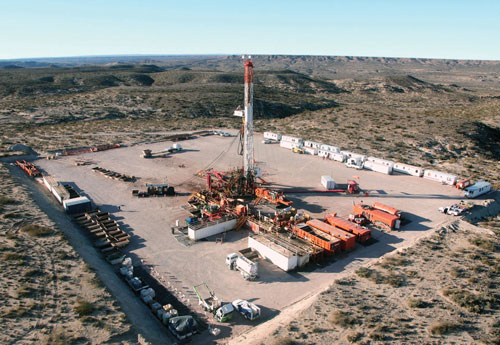 |
Argentina has begun exporting natural gas to Chile after a 12-yr interlude, as the two South American neighbors seek to increasingly integrate their energy supply and electricity grids.
The unconventional gas is being piped from Argentina’s oil- and gas-rich Vaca Muerta shale field in the Neuquen basin, then sent over the Andes mountain range to Chile’s southern province of Biobio.
The exports mark a turning point in energy trade in the region. Argentina, which sits atop the world’s second-largest shale gas reserves, was once a major supplier of natural gas to Chile, but it triggered a diplomatic crisis in the mid-2000s by cutting off shipments when its own supplies ran low.
The move sent Chile, a global mining powerhouse that has few hydrocarbons of its own, scrambling to find new sources of supply. The spat also helped foster a move toward alternative energy sources in Chile, like wind and solar.
The two countries have very different, but often complementary, energy needs. Depending on the time of year and circumstance, they can either export or import fuel and electricity across their shared border.
Emerson to modernize Sonatrach gas processing plant
Emerson, in partnership with Fores Engineering, has signed a $32-MM contract with Sonatrach, Algeria’s state energy company, to modernize its gas processing plant in Alrar. As part of the contract, Emerson will combine its technologies and operational certainty methodology to optimize Sonatrach’s production operations and improve the reliability and security of the Alrar plant’s processes.
Emerson’s modernization program at the Alrar gas processing plant, in the southeast part of Algeria, is designed to help Sonatrach achieve top-quartile performance—defined as operations and capital performance in the top 25% of peer companies.
The project strengthens Emerson’s presence in Algeria, which is a strategic market for the company in Africa. The project includes the engineering procurement, commissioning and testing of the new integrated control and safety systems, fire and gas systems, boosters and compressor controls, field instrumentation, liquid and gas metering skids, control and isolation valves, and other equipment for improved production efficiencies, equipment reliability and safety.
Sonatrach, an Algerian government-owned company that processes the hydrocarbon resources of the country, has diversified its activities to cover all aspects of the oil and gas industry value chain, including upstream (exploration and production), midstream (processing and transport) and downstream (refining, petrochemicals and marketing).
Total, CNOOC strengthen long-term cooperation in LNG
Total and CNOOC have increased their SPA contract volume from 1 MMtpy to 1.5 MMtpy of LNG, and have extended the term to 20 yr. The initial SPA, signed in 2008, had a contract volume of 1 MMtpy over 15 yr.




Comments